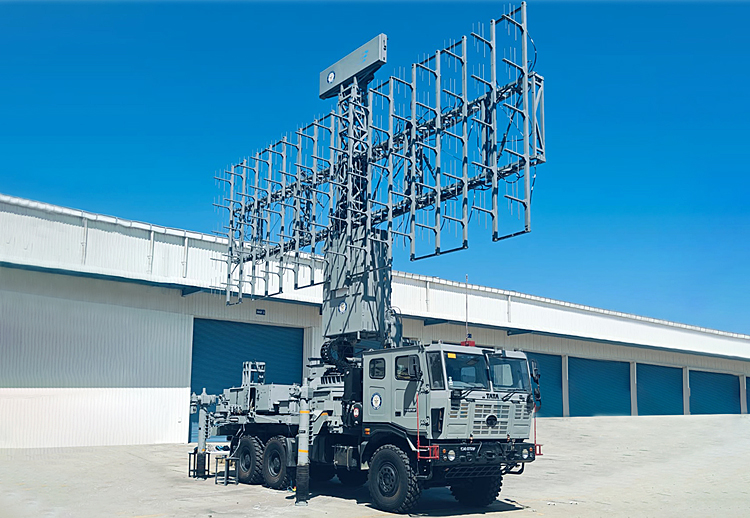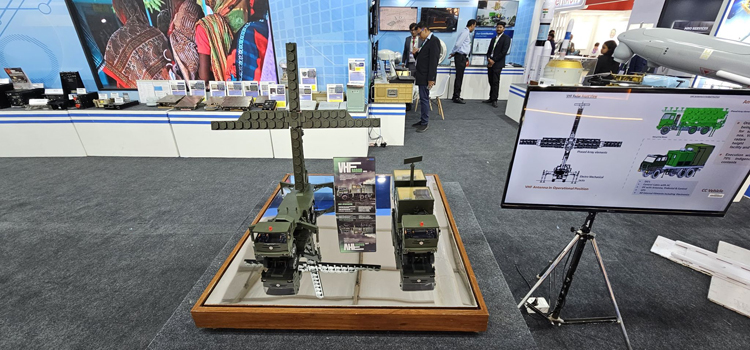INDIAN ARMED FORCES CHIEFS ON OUR RELENTLESS AND FOCUSED PUBLISHING EFFORTS

The insightful articles, inspiring narrations and analytical perspectives presented by the Editorial Team, establish an alluring connect with the reader. My compliments and best wishes to SP Guide Publications.

"Over the past 60 years, the growth of SP Guide Publications has mirrored the rising stature of Indian Navy. Its well-researched and informative magazines on Defence and Aerospace sector have served to shape an educated opinion of our military personnel, policy makers and the public alike. I wish SP's Publication team continued success, fair winds and following seas in all future endeavour!"

Since, its inception in 1964, SP Guide Publications has consistently demonstrated commitment to high-quality journalism in the aerospace and defence sectors, earning a well-deserved reputation as Asia's largest media house in this domain. I wish SP Guide Publications continued success in its pursuit of excellence.
- Appointments Committee of Cabinet approves one-month extension in service of Chief of the Army Staff
- Prime Minister witnesses 'Bharat Shakti' – a Tri-Services Firing and Manoeuvre Exercise in Pokhran, Rajasthan
- Interim Defence Budget 2024-25 — An Analysis
- Union Defence budget 2024
- Indian Army: In quest of greater firepower and policy recommendations for gaps
- Indian Army Annual Press Conference 2024
- Tata Boeing Aerospace Delivers 250 AH-64 Apache Fuselages, Manufactured in India
Stealth and Anti-Stealth
China Electronics Technology Group have reportedly developed a ground breaking device capable of detecting and precisely locating emissions from US stealth aircraft, potentially altering the strategic balance in military technology
 |
The Author is Former Director General of Information Systems and A Special Forces Veteran, Indian Army |

According to news reports of May 8, 2025, researchers at the 38th Research Institute of China Electronics Technology Group Corporation have reportedly developed a groundbreaking device capable of detecting and precisely locating emissions from US stealth aircraft, potentially altering the strategic balance in military technology. The device uses commercially available technology to detect low-probability-of-intercept radar (LPIR) signals, locates the source of emissions within 0.4-0.5 inches, even amidst active jamming, challenging traditional stealth advantages. According to the report, these new detection capabilities could force nations to reconsider their reliance on stealth strategies and invest in alternative military tactics.
In India, DRDO and BEL are jointly developing an advanced radar system to detect and track 100 stealth targets simultaneously at 400-km range, which are invisible to conventional radar
Unlike traditional radar systems, which broadcast strong, easily detectable signals, LPIR uses a combination of frequency hopping, noise-like waveforms, and adaptive power control. This allows US military platforms to detect enemy systems while remaining undetected themselves. LPIR is a vital component of American stealth aircraft such as the F-35 Lightning II and the F-22 Raptor, designed to remain undetected by emitting weak signals. The implications of this new Chinese device are profound, suggesting that low-cost technology could undermine sophisticated military systems.
Moreover, despite its sophistication, LPIR is not entirely foolproof. Current technologies, such as high-resolution wideband receivers and advanced signal analysis algorithms, have the potential to detect these elusive signals. Moreover, longer observation times and artificial intelligence tools can further enhance detection capabilities. How will nations adapt their military strategies in response to advancements in detection technology in the landscape of continuously evolving electronic warfare? This new Chinese device underscores the need for continual innovation in military technology to maintain a strategic edge, which India must take note of.
The Surya radar is a mobile, solid-state 3D radar system developed to track stealth aircraft and low-observable aerial targets
In India, the Defence Research and Development Organisation (DRDO) and Bharat Electronics Limited (BEL) are jointly developing an advanced radar system to detect and track 100 stealth targets simultaneously at 400-km range, which are invisible to conventional radar. This radar uses the modern semiconductor technology of Gallium Nitride (GaN) modules, making it more resilient to enemy jamming. To optimise its effectiveness, these radars could form part of an integrated network of multiple radar stations, creating an overlapping field of surveillance. This is a significant development, although question remain whether the range of 400-km is enough, should it not be 600-km, and whether this combined radar system can detect F-22 and J-35 fighter jets. Moreover, we also need long-range radars like 1,000-1,500 km range, including radars which can detect and track low flying high-speed missiles.

In a major step toward strengthening India's air defence capabilities, Bengaluru-based Alpha Design Technologies Private limited has delivered first of six stealth-detecting radars to Indian Air Force (IAF) under ₹200 crore contract. The indigenous Surya Very High Frequency (VHF) radar systems, developed entirely in India, was reportedly handed over in mid-March 2025. The Surya radar is a mobile, solid-state 3D radar system developed to track stealth aircraft and low-observable aerial targets. It operates in the VHF band, which allows it to detect targets that typically evade conventional high-frequency radar systems. Using longer wavelengths, the radar can identify stealth objects by minimising the effect of radar-absorbing materials. It offers a detection range of 360 kms for a target with a radar cross-section of 2 square meters and features a staring mode for enhanced tracking. Mounted on two 6×6 vehicles, the radar performs 10 rotations per minute to ensure full coverage. It is designed to support rapid deployment and operations in diverse terrains. Capabilities of the Surya radar to detect stealth aircraft, including Chinese J-20 fighters and Wing Loong drones, has attracted global attention. It is expected to complement other Indian-made systems like the 'Ashwini' low-level transportable radar developed by BEL.
Integration of the Russian 29B6 Container Radar system into India's air defence infrastructure would provide excellent protection against both conventional and unconventional threats
India is actively developing both stealth and anti-stealth capabilities to maintain a strategic edge in air warfare. This includes the development of the fifth-generation Advanced Medium Combat Aircraft (AMCA) stealth fighter, and the Surya VHF radar system mentioned above. The AMCA emphasises private sector involvement and international collaboration to accelerate its development. The AMCA project is aiming for a prototype rollout by 2028-29, with production expected to begin by 2032-33 and induction by 2034. The engine for the AMCA is expected to be a joint venture with a foreign OEM to leverage advanced technology and reduce risk. The Surya VHF Radar operates in the VHF band and uses longer wavelengths to detect low-observable targets that are difficult for conventional radars to track. It can detect stealth aircraft with a radar cross-section as low as 0.001 m² at ranges up to 350 km, using AI to enhance tracking capabilities and provide early warning.

According to news reports of May 26, 2025, India is also in talks with Russia for procurement of the advanced anti-stealth Container-S Radar System, specifically the 29B6 Container Radar through a government-to-government (G2G) deal. Discussions are also on for India to import Russia's Voronezh OTH radar system for bolstering air defences against stealth and long-range threats. Salient features of the 29B6 Container radar include: Bistatic OTH Radar – operating in the high-frequency (HF) band, utilising surface wave technology for enhanced defence capability; Long-Range Detection – capable of detecting airborne targets at distances exceeding 3,000 km, providing early warning against potential threats; Ballistic Missile Detection – specifically designed to monitor and track ballistic missiles, enhancing strategic defence capabilities; Airspace Surveillance – offers comprehensive long-range monitoring of airspace, critical for detecting low-observable stealth aircraft; High-Altitude Detection – can detect targets at altitudes of 100 km, covering a wide range of aerial threats; Wide Coverage – features a 240-degree view, enabling extensive surveillance over vast regions; Modular Design – the radar's receiving antenna system comprises 144 antenna-feeder masts, allowing scalability and adaptability.
During Operation 'Sindoor', Indian AD and electronic systems captured electronic signatures linked to the Pakistan Air Force's J-10C and JF-17 multirole fighter jets, as well as air-to-air and surface-to-air missile systems
Integration of the Russian 29B6 Container Radar system into India's air defence infrastructure would provide excellent protection against both conventional and unconventional threats. Its ability to detect targets at high-altitude and over vast distances and over vast distances would enable the Indian defence units to respond proactively against potential incursions or missile launches. In addition, the radar's bistatic OTH configuration enhances its resilience against electronic countermeasures, making it a critical asset in contested environments.
Finally, a major intelligence success was achieved during Operation 'Sindoor' with Indian AD and electronic systems capturing electronic signatures, including unique signal emissions and system behaviour linked to the Pakistan Air Force's J-10C and JF-17 multirole fighter jets, as well as critical air-to-air and surface-to-air missile systems; Indian radar arrays and ELINT platforms operating along the border successfully recorded signature-level emissions from Pakistan's frontline Chinese-origin weapon systems. This will be of great help in future battlefield engagements.





